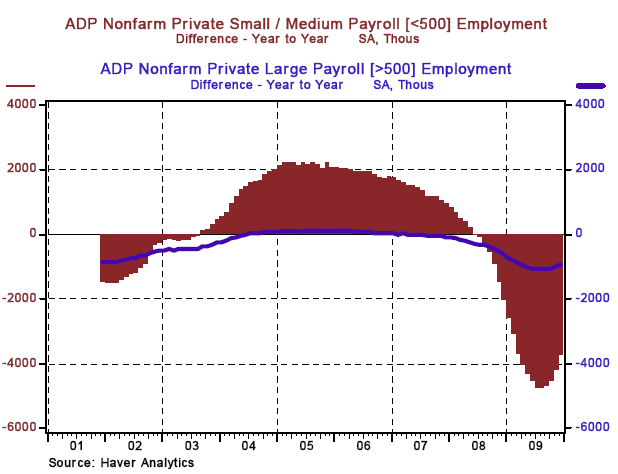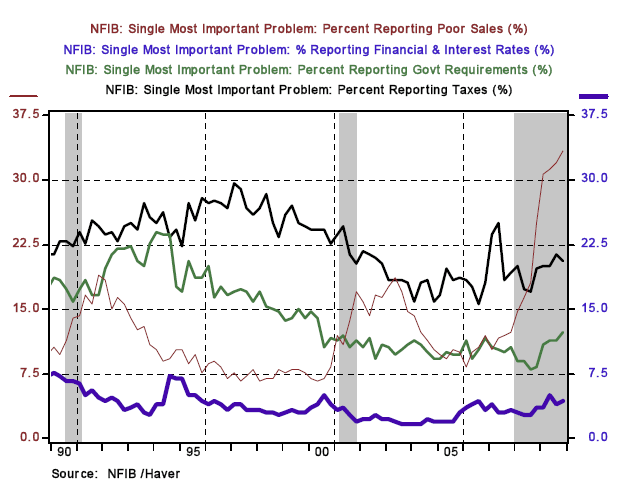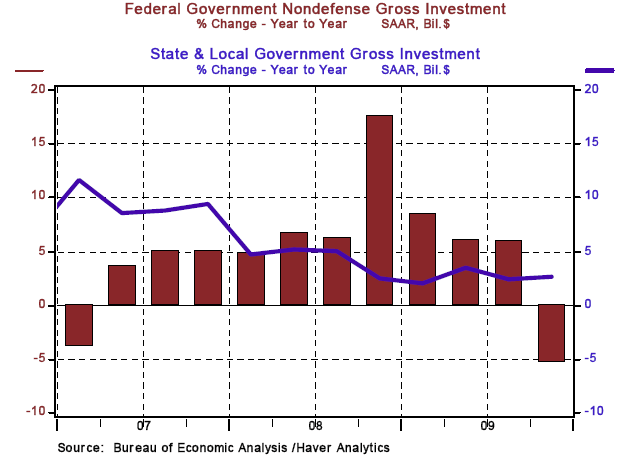Does Anyone in Washington Know What Needs to Be Done to Create Jobs?
Economics / Employment Feb 04, 2010 - 01:11 AM GMTBy: Paul_L_Kasriel
 This is a question that I often get as I speak to groups around the country. Based on the ADP monthly survey of employment, small- and medium-sized firms (less than 500 employees each) are the fount (or black hole, as of recent months) of jobs in the U.S. economy (see Chart 1).So, rather than asking Washington career politicians what it takes to create more jobs, why don't we poll small businessmen and businesswomen?
This is a question that I often get as I speak to groups around the country. Based on the ADP monthly survey of employment, small- and medium-sized firms (less than 500 employees each) are the fount (or black hole, as of recent months) of jobs in the U.S. economy (see Chart 1).So, rather than asking Washington career politicians what it takes to create more jobs, why don't we poll small businessmen and businesswomen?
Chart 1

In a sense, this is what the National Federation of Independent Business (NFIB) does every month. It surveys independent businesses each month about, among many things, what is the single most important problem they face. Presumably, if this problem were solved, these independent businesses would thrive and would be increasing their staffs. So, according to the "troops on the ground," what is the number one impediment to better business conditions and increased jobs in the economy? Too high taxes? Increased regulation? Too little credit? All of these problems have increased in recent months. But, by an order of magnitude, independent businesses report that their biggest problem today is poor sales (see Chart 2)! Can you imagine that? After a collapse in aggregate demand emanating from the longest and deepest recession in the post-war era, independent businesses need more demand for their products and services in order for them to step up their hiring. Why did not those career politicians in Washington think of this?
Chart 2

Some economists, of all people, actually did understand this problem years ago. Both J.M. Keynes, the founder of the school of economics named after him, and F.A. Hayek, an icon of the ultra-free-market Austrian school, both said that when the financial market is unable to create credit because of capital constraints and when private aggregate demand collapses, there is a role for increased government spending and central bank financing of that spending. Neither Keynes nor Hayek recommended such policies in "normal" times. In fact, Hayek argued that excessive central bank credit creation in normal times would ultimately lead to a depression.
But if, what he called a "secondary depression" was imminent or upon us, it should be avoided or mitigated by an increase in government spending and central bank credit creation to help finance the government spending. (For a discussion of Hayek's views on secondary depressions, see my July 30, 2009 Econtrarian "I Come Neither to Praise Nor Bury Bernanke." Neither Hayek nor Keynes believed that any good could be served by the deflation and unemployment that would accompany a secondary depression. In the early 1930s, it could reasonably be argued that the U.S. experienced a secondary depression. I believe that the U.S. was on the brink of secondary depression in late 2008.
So, maybe a combined program of increased government spending and abnormally-large increases in the Fed's balance sheet is just what these doctors of economics might have prescribed. For you see, aggregate demand is unambiguously increased when the federal government spends (or transfers spending power to other entities) and that federal spending is financed by credit created by the Fed. Increased aggregate demand for goods and services will trickle down to increased sales for small, medium and large businesses.
But some career politicians in Washington are arguing that the 2009 fiscal stimulus package, (The American Recovery and Reinvestment Act or ARRA) has been a failure. Others argue that the fiscal stimulus was too small, and another one is needed. Before we declare the fiscal stimulus a failure or enact yet another one, why don't we hold judgment until the ARRA has been fully implemented. You see, according to ProPublica, as of January 25, only approximately 30% of the $580 billion allocated spending in the 2009 fiscal stimulus program has actually been disbursed to date.
This is reflected in the latest GDP data. As shown in Chart 3, nominal federal government nondefense infrastructure spending contracted by 5.3% on a year-over-year basis in Q4:2009. Although nominal state & local government infrastructure spending was up 2.7%, this looks to be more of a business-as-usual-spending increase than anything out of the ordinary. Of course, had it not been for "Build America Bonds," an element of the fiscal stimulus program whereby state & local government issuers of taxable bonds to fund infrastructure projects receive an interest-cost rebate from the Treasury, this modest growth in local government infrastructure spending would have been less. The point is that there is approximately 70% of spending fiscal stimulus and approximately 56% of tax-cut fiscal stimulus still in the pipeline.
Chart 3

In sum, if what small- and medium-sized businesses need to increase their hiring is increased sales, then it would seem that fiscal stimulus coupled with Fed-created credit is the right medicine. In total, only about 33% of the combined tax-cut and spending in the ARRA has been allowed to stimulate. So, before we decree that the ARRA has been a failure or before we enact a supplemental program, let's see how the current one plays out when more of the funds have been dispersed. Come to think of it, perhaps some career politicians in Washington do know something about helping small businesses to create jobs when faced with the prospects of a secondary recession.
Note: For an interesting read on Keynes, Hayek, Friedman and other luminaries of economic philosophy, pick up a copy of Bruce Bartlett's new book, The New American Economy. Rather than accentuating the differences among these luminaries, he discusses some important common ground among them, which is relevant in the current economic environment. Regrettably, I have no monetary interest in the sale of this book.
Paul Kasriel is the recipient of the 2006 Lawrence R. Klein Award for Blue Chip Forecasting Accuracy
by Paul Kasriel and Asha Bangalore
The Northern Trust Company
Economic Research Department - Daily Global Commentary
Copyright © 2010 Paul Kasriel
Paul joined the economic research unit of The Northern Trust Company in 1986 as Vice President and Economist, being named Senior Vice President and Director of Economic Research in 2000. His economic and interest rate forecasts are used both internally and by clients. The accuracy of the Economic Research Department's forecasts has consistently been highly-ranked in the Blue Chip survey of about 50 forecasters over the years. To that point, Paul received the prestigious 2006 Lawrence R. Klein Award for having the most accurate economic forecast among the Blue Chip survey participants for the years 2002 through 2005.
The opinions expressed herein are those of the author and do not necessarily represent the views of The Northern Trust Company. The Northern Trust Company does not warrant the accuracy or completeness of information contained herein, such information is subject to change and is not intended to influence your investment decisions.
Paul L. Kasriel Archive |
© 2005-2022 http://www.MarketOracle.co.uk - The Market Oracle is a FREE Daily Financial Markets Analysis & Forecasting online publication.



